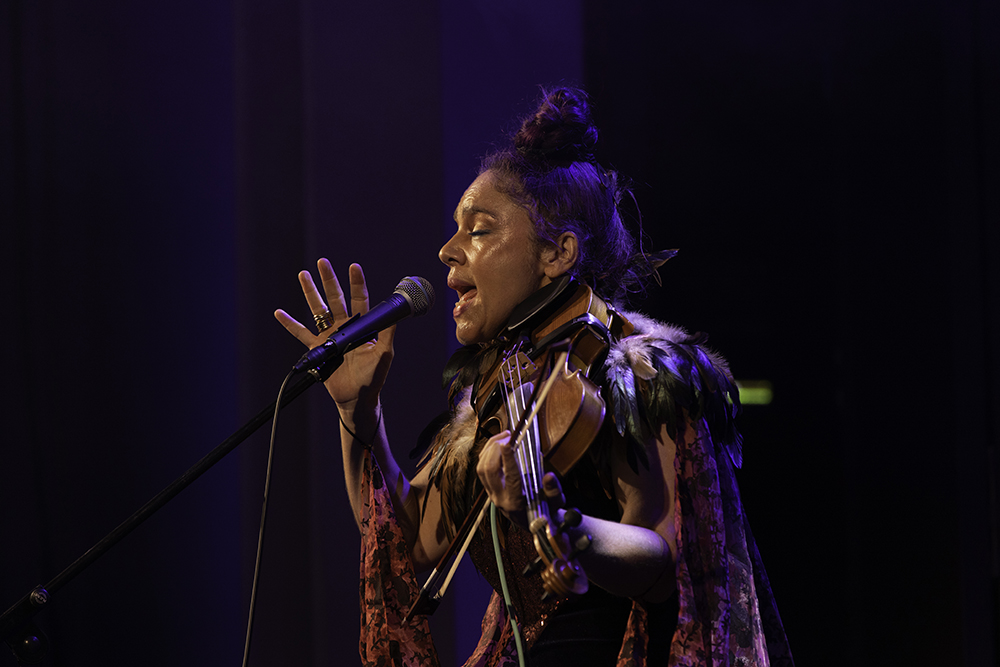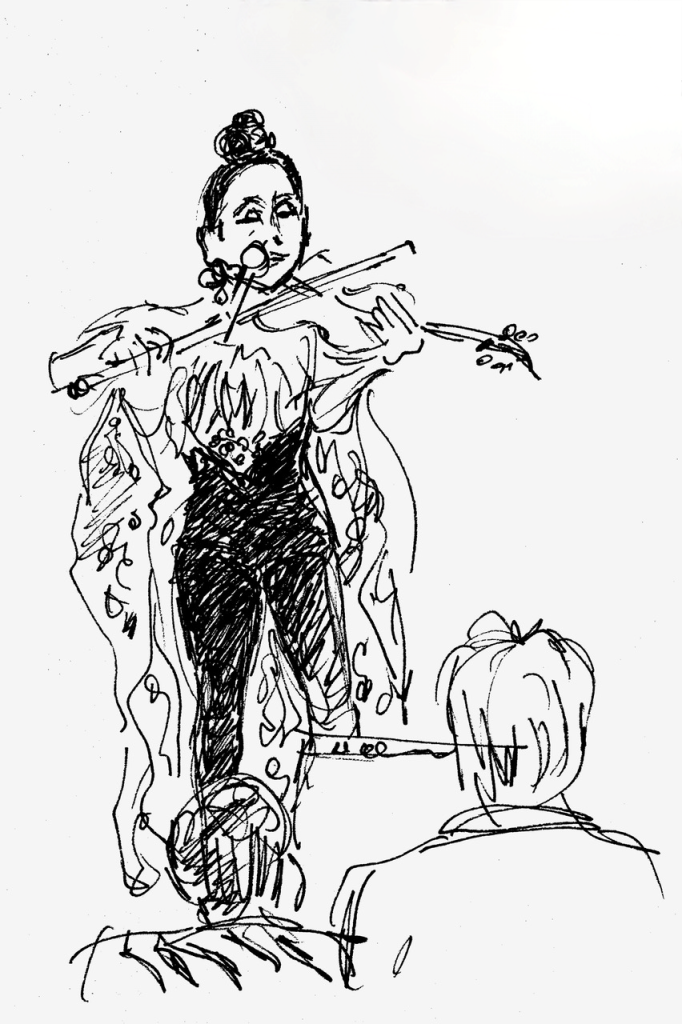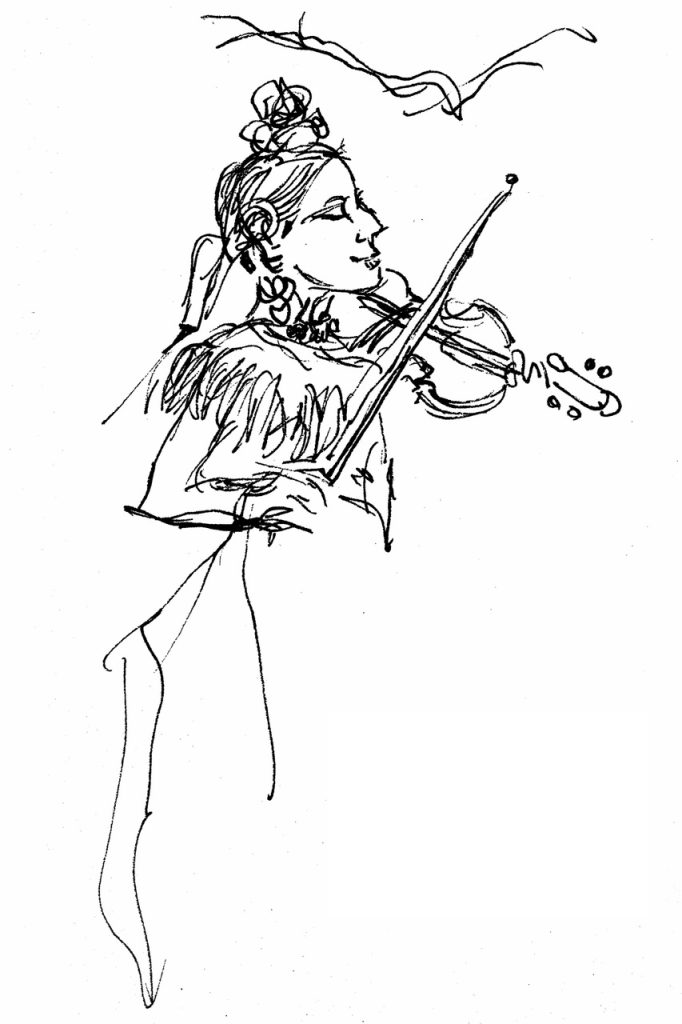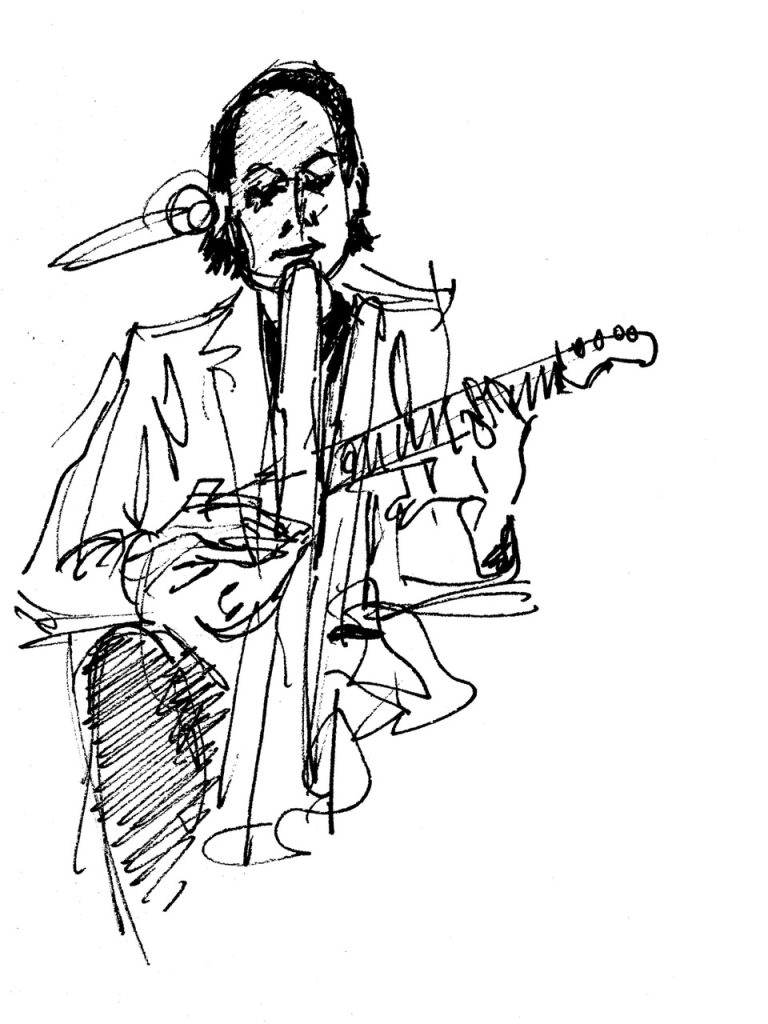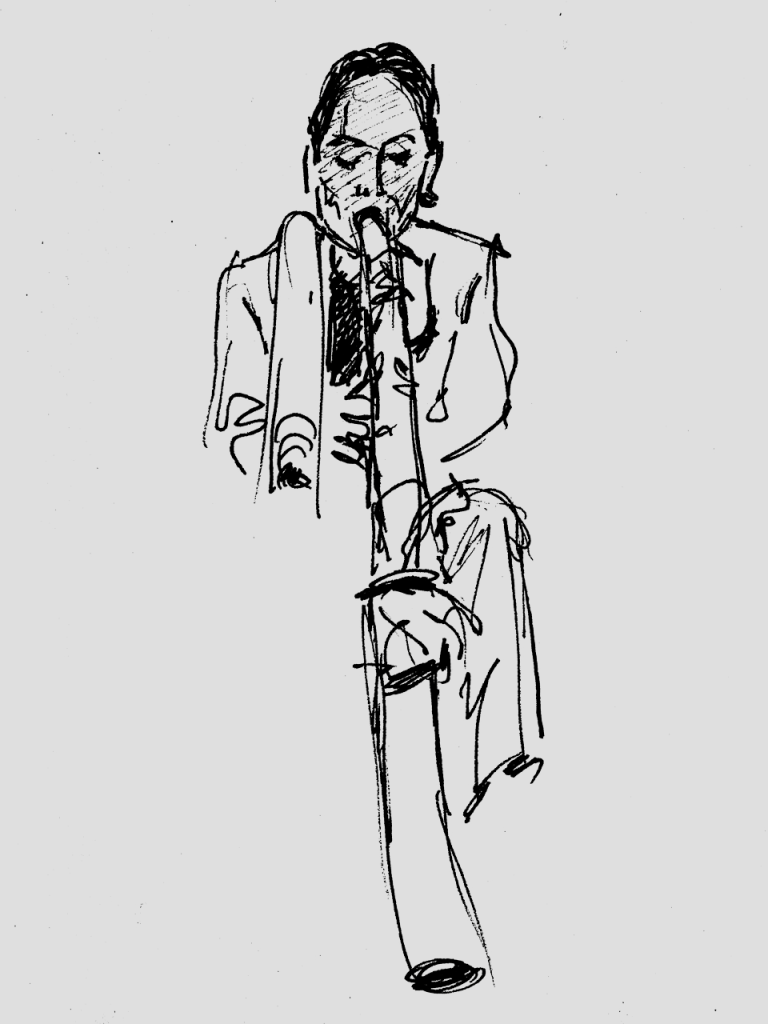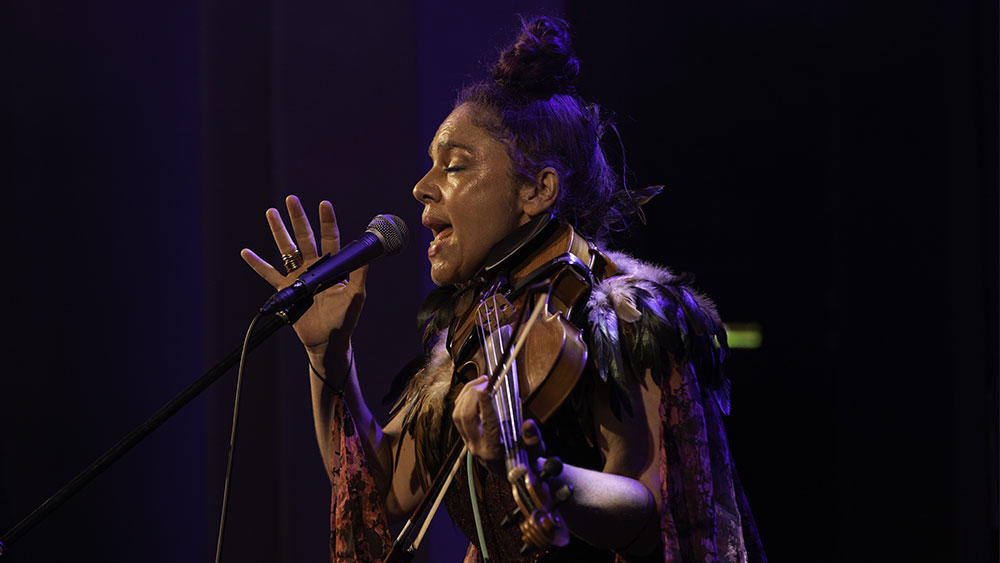
Review: Veronique Serret’s Migrating Bird at The Embassy
Veronique Serret’s Migrating Bird at The Embassy
Wednesday, February 19, 2025
Last week, Perth Festival presented Migrating Bird, a powerful and adventurous concert by Australia-based Mauritian composer/performer Véronique Serret. In the Perth Town Hall, her tight core trio—Serret (acoustic and six-string electric violin), Richard Daniell (percussion), and Samuel Pankhurst (double bass)—were joined for three of the eight pieces by Serret’s principal collaborator, the composer and ‘didgeridoo legend’ William Barton (didge/electric guitar). In front of a stunning backdrop by videographer Toby Burrows, through their magical esoteric music, they explored a wild and organic soundscape.
Véronique Serret is one of those rare musicians who is equally at ease in classical and popular realms. Her performance appearances range from the Sydney Symphony Orchestra and the ACO to Archie Roach, Joanna Newsome and Sarah Blasko. In recent years, however, she has shifted her focus to New Music and developing her own compositional voice.
As her bio puts it, ‘Folk, rock, experimental jazz, dance, and improvisation all contribute to her musical palette.’ All were at play within her Perth concert, especially improvisation. Hypnotic, trance-like, looped, and layered, she describes her almost ambient music as ‘a collaboration with nature.’
The show opened with Brookfield, a work named after the rural residential area on the outskirts of Meanjin (Brisbane) where Serret retreated for some months during COVID.
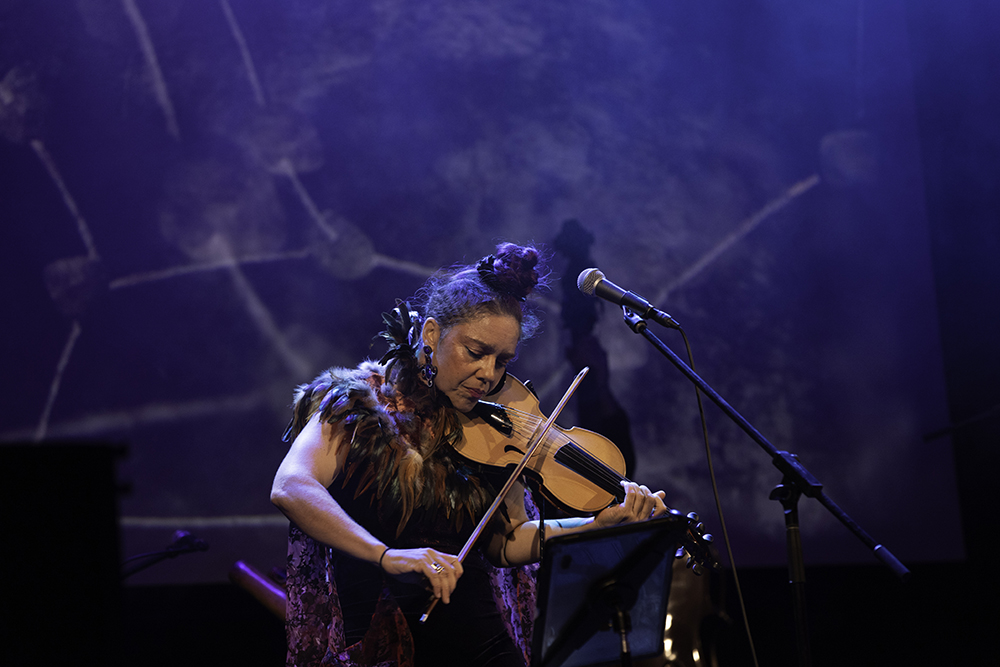
The piece began gently with solo violin, a plaintive line underpinned by a bowed bass drone. Gradually the percussion joined in to create a discordant whirl that ended with a late and haunting lyric. As the other instruments fell away, the voice remained, marking the range of Serret’s musicality.
This is the first time Serret has used vocals in her compositions, the final ingredient in her musical arsenal. Through both spoken word and abstract melody lines, her fine and rich voice weaves effortlessly through her multilayered violin phrases, giving the whole a haunting and deeply human edge.
For the second piece, Carbon Footprint, Serret welcomed Barton onto the stage. His didge added a primordial element to the rhythmic pulse, rounding out the ensemble’s sonic foundation. As the piece built in intensity, becoming at times almost cacophonous, the repeated line ‘nature’s dancefloor’ reflected the mood.
The third, eponymous work, Migrating Bird, was notable for Daniell’s percussion. Although seated at a conventional kit, his playing was anything but ordinary. A bowed vibraphone is not unusual in New Music, but a bowed kit definitely is. Falling into a rhythmic dance, Daniell by turns ran his violin bow up the edge of his various cymbals, along the rim of his snare, and down the side of the cowbell to create a pattern of humming tones. He only broke the spell at the climax when he took up mallets. It was extraordinary playing, masterful and mesmerising.
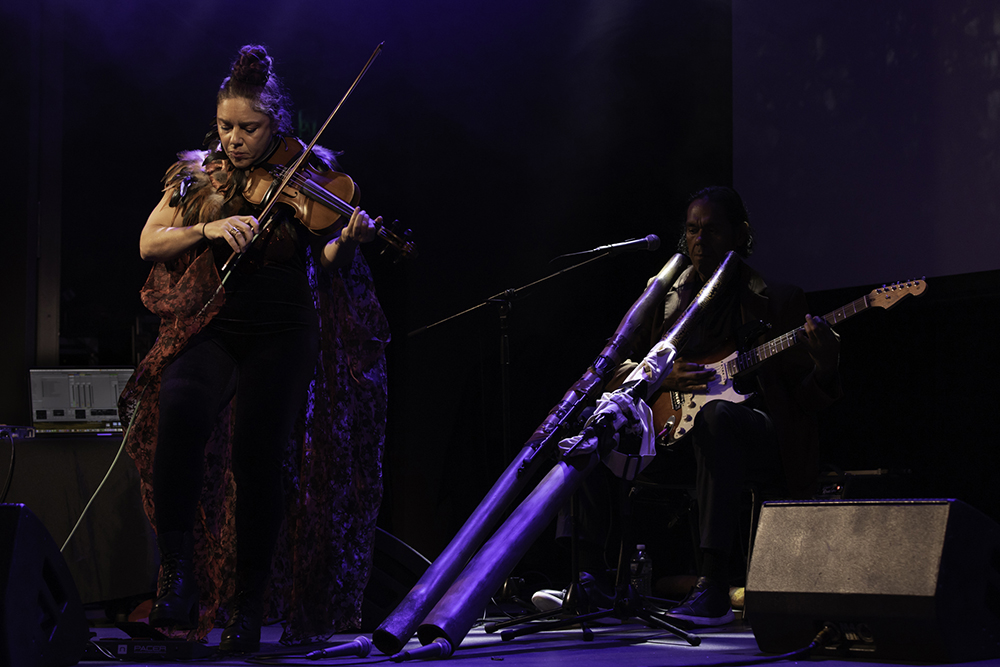
The first half of the concert, Side A as Serret described it following the LP format, finished with Topsy Turvy World, a vocal meditation built around a simple four-note violin ostinato.
Migrating Bird is another in the long line of artworks to come from the COVID years. Creativity seems to be one of the few pursuits to have really benefitted from that enforced isolation. While sequestered in Brookfield, Serret immersed herself in the nearby Mount Coot-tha forest.
“When the world stood still and our cities took pause
I turned to Mother Nature.
I walked and walked and listened deeply.
This is what she said to me.”
In preparation for her Perth show, Serret spent several hours walking through Kings Park. “How lucky you are to have such magnificent bushland in the heart of your city,” she said, introducing one piece. She was particularly taken by the abundant bird life.
While landscapes and land birds underpinned ‘Side A,’ water and waterbirds came to the fore on ‘Side B.’
Serret plays her violin through an effects rack like an electric guitarist. Chorus, reverb, harmonizer, distortion, and loops are all part of her sonic kit.
On Watercolour, it was fascinating how the fractured phrases were held together. The melodic violin lines, looped and layered, interwoven with wistful vocal phrases, seemed to be thrown into space only to land perfectly on the bed laid by Pankhurst and Daniell.
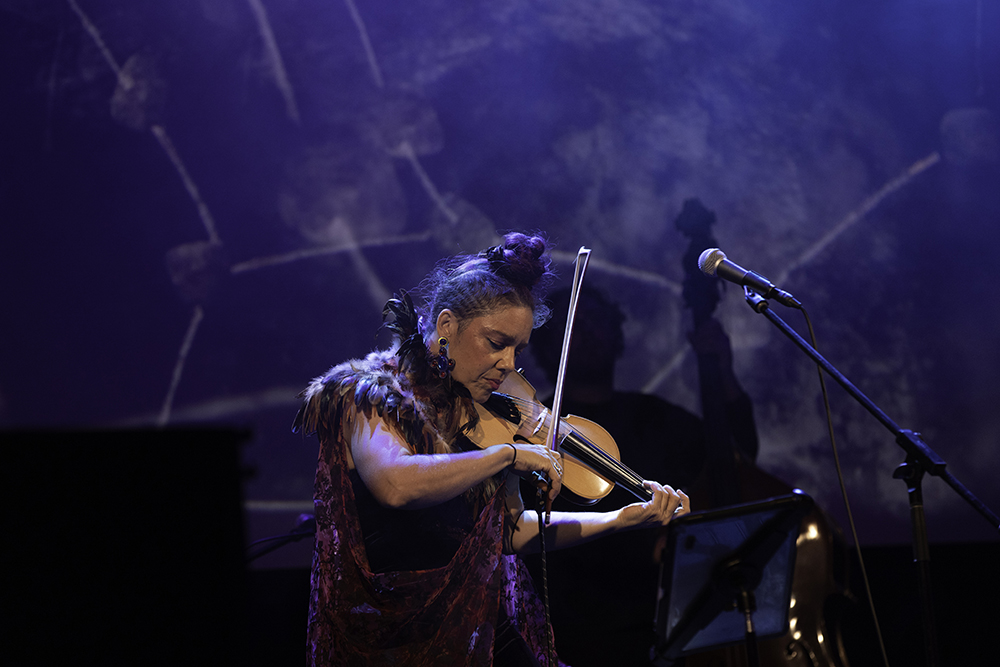
They took this even further in River Run Deep, where a carefully constructed four-tiered violin and voice loop set the ground for a beautiful violin solo.
On the last two pieces, Pelican Song and Dodo, Barton rejoined the ensemble to masterfully play simultaneously his double didge and Fender Telecaster. The Tele’s raw rhythmic guts drove the growing fractious cacophony of these final works, forcing them onto a deep current of free-floating sound. It was extraordinary; the audience was transported to somewhere rich and strange.
In addition to her solo work, Serret is a member of the art music group Ensemble Offspring and crucially in an ongoing collaborative duo with William Barton. Over the past five years, the two have worked on a number of commissions from prestigious Australian musical institutions, including the Sydney Symphony, Sydney Festival, and the Canberra International Festival of Music.
As well as Migrating Bird (2024), Serret has released three other albums: one classical (JS Bach’s Partita No. 2 in D minor, 2014), one collaboration with Barton (Heartland, 2021), and one of four commissioned works for six-string electric violin (Prima Volta, 2022).
Unlike the concert, on the Migrating Birds album, Serret utilises multi-tracking, looped phrases, and ambient nature recordings, so that in the main she plays and sings alone. The only other accompaniment is Barton’s didge and guitar on two tracks. The current tour, of which Perth was the final stop, gave her the opportunity to further explore the composition’s potential through collaboration and improvisation. As the album is complete in its complexity, the live versions present a parallel journey, the path not taken.

The Perth Town Hall in cabaret mode was perhaps not the best venue for a concert of this type. Given their growing prominence in New Music circles, The Rechabite or WA Museum’s Hackett Hall may have been better suited. The satin swags and bunting of ‘The Embassy’ ballroom décor were at odds with the tenor of the performance, and there were a few too many empty seats at the round, lamp-lit tables, people being less inclined to share at those intimate configurations. Worse, in the hour between the doors opening and the show starting, the background music was too loud for comfortable conversation.
The audience too were an odd fit. There were many older people, not necessarily those normally drawn to challenging experimental music. Some were attracted by the nature theme and may not have realised quite what they were in for. It’s heartening when a festival enables an artist to reach a different audience, and, given their enthusiastic applause and some comments afterwards, this one clearly enjoyed it.
The irony, though, is that there is a considerable following in Perth for esoteric new music like this. Although a few of this cohort were present, it was nowhere near the number you would find at a gig of such high quality presented by the likes of Tura New Music.
No doubt these are teething problems that the festival will address when it evaluates the innovations in its 2025 program.
There is a fine line between influence and imitation. Clearly, Serret has fallen heavily under the spell of Laurie Anderson, and not only the early work acknowledged in the promo. The two of them once shared a residency. Listening to Migrating Bird back-to-back with Anderson’s Kronos Quartet collaboration Landfall (2018), it’s hard to pick where one ends and the other begins. Their sonic landscape and language have so much in common. Even so, being such a rich and dense terrain, it can comfortably accommodate two explorers working on parallel paths. Moreover, in her collaborations with Barton and the realms they explore together, Serret’s unique compositional voice comes to the fore. Over this complete and complex geography, Véronique Serret is a sure-footed explorer.
IAN LILBURNE
Photos by Marnie Richardson
Sketches by Tish Oldham



